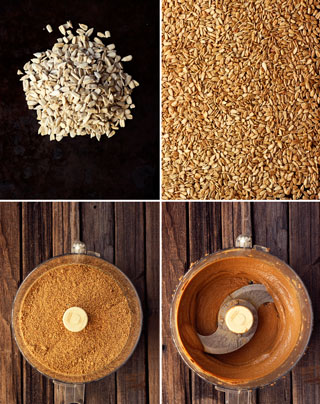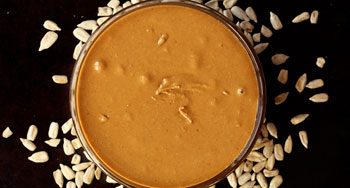
How to Make Homemade Nut Butters

As someone who tries to make nearly everything that I eat from scratch, I have found myself involved in some really fun DIY challenges in my kitchen. Earlier this year I started making my own nut butters. This has been one of my all-time favorite do-it-yourself discoveries.
Not only is it super easy to make your own nut butter, it is also so much cheaper than store-bought. Of course, there are also no strange preservatives or ingredients you can’t pronounce, just the few fresh ingredients that you use yourself.
What Nuts?
Basically, if it’s a nut (and even many seeds) and you like it, you can make a butter out of it. At home I have made nut butters from almonds, cashews, pecans, hazelnuts (for homemade “Nutella”), and more.

Soaking Nuts
Most nuts, seeds, grains, and beans are covered in natural chemicals – enzyme inhibitors and toxins – that protect them while growing, both from sprouting prematurely and also from predators. Phytates (physic acid), polyphenols (tannins), and goitrogens are enzyme inhibitors. Once harvested, those same chemicals (the major one being phytic acid) are indigestible to the human body and must be broken down before consumption. When food containing phytic acid is consumed, the acid combines with important minerals like calcium, magnesium, copper, iron, and especially zinc in the intestinal tract and blocks their absorption, which inhibits our digestive systems’ ability to break the nut down properly.
The very simple process of soaking releases these chemicals, helping you to absorb your food’s essential minerals and nutrients. Additionally, by soaking the nuts and removing the nutritional inhibitors, the flavor is much more appealing.



A few notes on soaking:
- Only soak nuts for making nut butter if you can dehydrate them (see soaking chart for dehydrating how-to).
- The soaking water from nuts and seeds should always be discarded and never used as water in a recipe.
- When making homemade nut butter, you can either do so with soaked/dehydrated nuts or you can roast them after dehydration to develop a deeper, toastier flavor. This step is optional.
- If soaking isn’t important to you, go ahead and roast the raw nuts and use those.
- I personally always opt for organic nuts whenever possible to minimize my exposure to any unnecessary toxins, chemicals, pesticides, and the like.
Homemade Nut Butter
(Gluten-free, Grain-free, Dairy-free, Egg-free, Soy-free, Vegetarian, optionally Refined Sugar-free and Vegan)
- 2-4 cups soaked and dehydrated raw nuts (optionally roasted, see note at end of recipe)
- 1-2 tablespoons neutral, light tasting oil (I prefer coconut oil)
- Fine sea salt, to taste (optional)
- Sweetener to taste, such as maple syrup, honey, raw cane sugar, coconut sugar, coconut nectar, etc. (optional)
After soaking and dehydrating, add the nuts to the bowl of a 14-cup food processor. (If you have a smaller processor, reduce the nuts proportionately. There needs to be enough room for the nuts to move to convert to butter. I find 2-3 cups to work the best in my 14-cup processor. More than 3 cups definitely works but takes a bit longer to process.)
Process the nuts to a fine powder, which will take 2-10 minutes. As you process, you may want to add some oil. I personally recommend it, as it helps to keep things moving.
As the nuts release their oils and the mixture continues to warm, it should turn creamy and move easily inside the bowl of your processor. If not, it is okay to add a bit more oil until the mixture is runny and blending smoothly. It may take up to 15-20 minutes until it is totally creamy. That will depend on the strength and size of your food processor and the quantity of nuts. Be patient.
If adding salt and/or sweetener, do so at the very end.
Important Notes:
- This recipe requires the use of completely dry nuts, so please don’t skip the dehydrating step when using soaked nuts.
- Nuts can be roasted or unroasted. If roasting, place your nuts in a single layer on a baking pan and roast in a 325ºF oven for 10-15 minutes, watching them very carefully. Roasted nuts have a deeper flavor. I personally find certain nuts are just better raw and others are better roasted. Experiment and find what you like best.
- The amount of oil needed will vary depending on the variety of nut used. Most nuts will need a little oil. You can play this by ear, adding as much as necessary to create a smooth butter. I have used none at times and other times I have needed as much as 3 or 4 tablespoons. Adding oil helps to move the process along and produces much creamier results.
- No matter how tempting it is, NEVER add water to your nut butter. It will produce a pasty, non-creamy result and the nut butter will spoil faster.

Fun Flavor Ideas:
- Vanilla Bean Cashew Butter
- Spiced Maple Pecan Butter
- Dairy-Free Chocolate Hazelnut Butter (aka “Nutella”)
Optional Add-ins:
- Vanilla extract or fresh vanilla bean
- Baking spices such as cinnamon, nutmeg, ginger, cloves, etc.
- Raw cacao or cocoa powder
- Herbs and spices for savory nut butters such as chili powder, curry, cumin, oregano, garam masala, rosemary, etc.
NOTE:
Always process nut butters completely first, then add any extra flavor ingredients to the finished butter by stirring in by hand or quickly processing for 1 minute or less.

Can’t Have Nuts?
Sunflower seed butter is super simple to make and is a wonderful substitute in most recipes that call for peanut butter. I find that toasting the sunflower seeds is necessary for getting the most toasty, nutty flavor possible.
Sunflower Seed Butter
(Gluten-free, Grain-free, Dairy-free, Egg-free, Nut-free, Soy-free, Vegetarian, optionally Refined Sugar-free and Vegan)
- 2-4 cups soaked and dehydrated raw sunflower seeds
- 1-2 tablespoons neutral, light tasting oil (I prefer coconut oil)
- Fine sea salt, to taste (optional)
- Sweetener to taste, such as maple syrup, honey, raw cane sugar, coconut sugar, coconut nectar, etc. (optional)
Preheat the oven to 325ºF. After soaking and dehydrating the sunflower seeds, spread them in a single layer onto a baking sheet. Roast the sunflower seeds for 10-15 minutes, watching very closely so they don’t burn.
In the bowl of a 14-cup food processor, add the toasted sunflower seeds. (If you have a smaller processor, reduce the seeds proportionately. There needs to be enough room for the seeds to move to convert to butter. I found 2-3 cups to work the best in my 14-cup processor. More than 3 cups definitely works but takes a bit longer.)
Process the seeds to a fine powder, which will take 2-10 minutes. As you process, you may want to add some oil. I personally recommend it, as it helps to keep things moving. Continue processing, stopping to scrape down the sides of the bowl every minute or two.
As the seeds release their oils and the mixture continues to warm, it should turn creamy and move easily inside the bowl of your processor. If not, it is okay to add a bit more oil until the mixture is runny and blending smoothly. It may take up to 15-20 minutes until it is totally creamy. That will depend on the strength and size of your food processor and the quantity of seeds. Be patient.
If adding salt and/or sweetener, do so at the very end.

Storing Nut & Seed Butters
Nut/seed butters will keep for several weeks in a covered glass jar in the refrigerator. You can also freeze them for up to 4 months.
 ABOUT THE AUTHOR:
ABOUT THE AUTHOR:
Beth Manos Brickey, a designer and yoga teacher, is also the recipe developer and photographer behind the gluten-free website Tasty Yummies (www.tasty-yummies.com).
Beth’s real food recipes are simple, humble, and approachable for the novice in the kitchen, but exciting and adventurous enough for the seasoned home chef.




Pingback: Homemade Nut Butter | Simply Gluten Free Magazine
Pingback: Sunflower Seed Butter | Simply Gluten Free Magazine